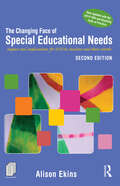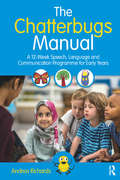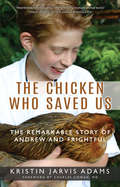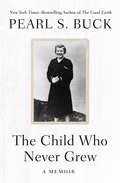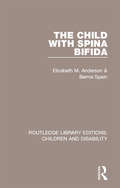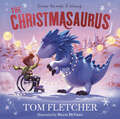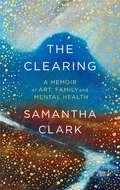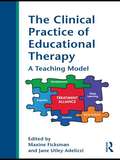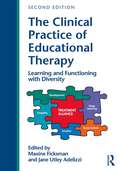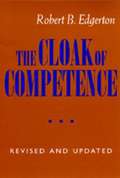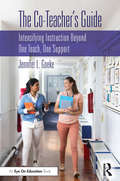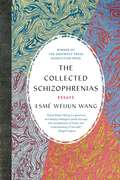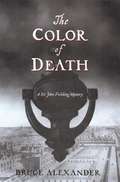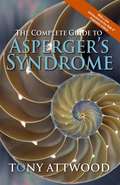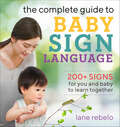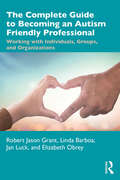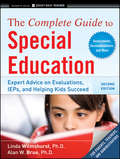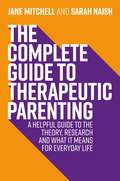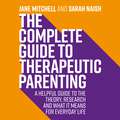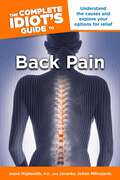- Table View
- List View
The Changing Face of Special Educational Needs: Impact and implications for SENCOs, teachers and their schools
by Alison EkinsFully revised with the requirements of the 2014 new SEN Code of Practice, this second edition of The Changing Face of Special Educational Needs shows teachers, SENCOs and students in teacher training how to respond to the rapidly changing context of special education. This highly practical and accessible text unlocks the often confusing field of special education provision in schools today by: Summarising and clarifying new policy directions as they emerge, in light of the new SEN Code of Practice Suggesting clear, practical activities to bring the theory to life, helping practitioners to review and reflect upon their work; Encouraging critical reflection about existing systems within the school context, considering whether these will remain appropriate and ‘fit for purpose’; Giving opportunities for teachers, SENCOs and senior leaders to contextualise the new changes in terms of the implications for practice in their own school. Including a new chapter on Using Technologies to Support the Development of Inclusive Practices, this text is packed with activities, case studies and points for reflection. It will help the teacher, SENCO, senior leader or advisor to make sense of the rapid pace of change of policy and terminology related to SEN and supports readers in a positive way, emphasising the exciting opportunities that these changes will provide for developing new, innovative and creative working practices. This book will also be essential reading for all SENCOs completing the National Award for SEN Coordination.
The Chatterbugs Manual: A 12-Week Speech, Language and Communication Programme for Early Years
by Andrea RichardsThe Chatterbugs Manual is a practical resource for all those supporting the development of the foundation communication skills of attention and listening, turn-taking and early vocabulary in children. The Chatterbugs programme has been designed to bridge the gap between education and specialist speech, language and communication provision, specifically with Early Years mainstream settings in mind. It enables school staff to prepare children—including those with delayed communication skills, EAL learners, or children with suspected special education needs—for learning in school by developing their communication skills through the use of robust communication strategies. The Chatterbugs Manual contains: An overview of the programme, including step-by-step instructions on how to plan and deliver a Chatterbugs session Guidance on identifying children likely to benefit from the programme Progress Tracking documents, along with information on measuring outcomes Child-friendly, illustrated session resources Frequently Asked Questions A parent-friendly information leaflet Information on models of implementation Information on accessing training and support Developed by an experienced speech and language therapist, Chatterbugs has consistently recorded successful outcomes for over 80% of participants since the programme’s inception in 2012, and for over 90% of participants since 2016. With its hands-on approach, the programme is an essential resource for educators, support staff, and speech and language therapists working with Early Years children.
The Chicken Who Saved Us: The Remarkable Story of Andrew and Frightful
by Kristin Jarvis AdamsThe true story of an autistic boy with a body under siege by mysterious illness, and the chicken who saved his life."Heartbreakingly beautiful - the gift of the human animal bond.” - Temple Grandin, Author, researcher, consultant and world-renowned autism spokespersonEight-year-old Andrew was autistic and bilingual. He spoke English - and Chicken. But the day he told his pet chicken Frightful that his body was trying to kill him, Andrew’s family and an entire medical community were launched into a decade-long quest for answers. This honest memoir of fierce and faithful parenting takes readers on a heartfelt journey through chronic illness and Asperger’s syndrome to discover the healing bond between a boy and his chicken. Navigating the complex landscape of modern medicine and genetics, through a rare diagnosis of Trisomy 8 Mosaicism and an experimental bone marrow transplant, readers venture to places where chickens talk, superheroes come alive, and a boy on the brink of death finds the courage to survive.
The Child Who Never Grew: A Memoir
by Pearl S. BuckA &“groundbreaking&” memoir about raising a special-needs daughter in an era of misinformation and prejudice—a classic that helped transform our perceptions (Publishers Weekly). It was my child who taught me to understand so clearly that all people are equal in their humanity and that all have the same human rights. Pearl S. Buck is known today for earning a Nobel Prize in Literature and for such New York Times–bestselling novels as The Good Earth. What many do not know is that she wrote that great work of art with the motivation of paying for a special school for her oldest daughter, Carol, who had a rare developmental disorder. What was called &“mental retardation&” at the time—though some used crueler terms—was a disability that could cause great suffering and break a parent&’s heart. There was little awareness of how to deal with such children, and as a result some were simply hidden away, considered a source of shame and stigma, while others were taken advantage of because of their innocence. In this remarkable account, which helped bring the issue to light, Pearl S. Buck candidly discusses her own experience as a mother, from her struggle to accept Carol&’s diagnosis to her determination to give her child as full and happy a life as possible, including a top-quality education designed around her needs and abilities. Both heartrending and inspiring, The Child Who Never Grew provides perspective on just how much progress has been made in recent decades, while also offering common sense and timeless wisdom for the challenges still faced by those who love and care for someone with special needs. It is a clear-eyed and compelling read by a woman renowned for both her literary talent and her humanitarian spirit. This ebook features an illustrated biography of Pearl S. Buck including rare images from the author&’s estate.
The Child With Special Needs
by Stanley I. Greenspan Serena WiederThis book describes various challenges that some children with special needs might face. The author goes into great detail about the floor time treatment method as well as describing the impact having a child with special needs has on the family.
The Child with Spina Bifida (Routledge Library Editions: Children and Disability #3)
by Elizabeth M. Anderson Bernie SpainFirst published in 1977, this book focuses on the disability of spina bifida in children. Children with the condition frequently suffer with severe physical handicaps such as lower limb paralysis and incontinence, as well as intellectual impairment. It can be difficult for the families of these multiply handicapped children and they often require the help of professionals from many disciplines. In this book, the authors focus on practical suggestions for alleviating many of the problems brought about by the condition. Their suggestions are designed to help parents, as well as professionals.
The Christmasaurus
by Tom FletcherMove over, Rudolph! It's time for the Christmasaurus to lead Santa's sleigh.The Christmasaurus is a dinosaur who lives with Santa Claus and his elves at the North Pole. More than anything, he wants to fly with Santa's reindeer on Christmas Eve! But no matter how hard he tries, he can't seem to figure out how to fly. . . . Until one Christmas Eve, when he meets a young boy in a wheelchair who has a wonderful idea. What if all the Christmasaurus needs is someone to believe in him? With playful, rhyming text, international bestselling author Tom Fletcher adapts part of his novel into a heartwarming picture book about friendship and the power of believing that is sure to become a new Christmas classic.
The Clearing: A memoir of art, family and mental health
by Samantha ClarkThis house has been a regular presence in my life for as long as I can remember. My heart has sunk a little every time I walk in . . .Samantha Clark enjoyed a busy career as an artist before returning home to Glasgow to take care of the house that her parents had left behind. Moving from room to room, sifting through the clutter of belongings, reflecting on her mother's long, sedated years of mental illness and her father's retreat to the world of amateur radio and model planes, Samantha began to contemplate her inheritance.A need for creativity and a desire for solitude had sprung up from a childhood shaped by anxiety and confusion. Weaving in the works and lives of others, including celebrated painter Agnes Martin and scientist of dark matter Vera Rubin, The Clearing is a powerful account of what we must do with the things we cannot know.'Samantha Clark writes on the subtle edge of words and thought. She renders the world within and the world of ideas with electric sensitivity and acute intelligence' Jay Griffiths
The Clinical Practice of Educational Therapy: A Teaching Model
by Maxine Ficksman Jane Utley AdelizziThe Clinical Practice of Educational Therapy is the first book to provide a comprehensive review of the interdisciplinary profession and practice of educational therapy as it exists today. It describes the scope and practice of educational therapy from its European roots to its growing presence in the United States, and provides case studies to illustrate the work of educational therapists. Key Features: Interdisciplinary Perspective - Other books focus on either educational or therapeutic interventions but rarely discuss the blend and synergy of disciplines that are the hallmark of the profession. Illustrative Cases - The text draws heavily on case studies as a means of understanding the practice of educational therapy, especially the relationship between therapist and client. Expertise - Chapter authors are either experienced educational therapists or allied professionals who have made scholarly contributions to the profession, such as Dorothy Ungerleider, Patricia Waters, Roslyn Arnold, and George McCloskey. In addition to educational therapy students and practitioners, this book is appropriate for those working in related fields including special education, school psychology, school counseling, and social work in educational settings.
The Clinical Practice of Educational Therapy: Learning and Functioning with Diversity
by Maxine Ficksman Jane Utley AdelizziDespite the wide array of services offered to students with learning disabilities, attention-deficit disorder, and a variety of comorbid conditions, large numbers of students are caught in the struggle of surviving school. Unfortunate school experiences may impact their sense of self and the degree of tenacity with which they pursue further training or challenging opportunities in the workplace. These are the people for whom educational therapy provides relief, enlightenment, and the coveted prize of success. The second edition of The Clinical Practice of Educational Therapy, the first textbook in its field, provides a comprehensive perspective of this interdisciplinary profession and practice, reaching out to a more global audience. The book describes the scope and practice of educational therapy from its European roots to its growing presence in the United States, providing readers with case studies and research that illustrate the work of educational therapists across the lifespan in diverse settings. Interdisciplinary Perspective — Other books focus on either educational or therapeutic interventions but rarely discuss the blend and synergy of disciplines (e.g., special education, neuropsychology, assessment, and social work) that are the hallmark of this unique profession. Illustrative Cases — The text draws heavily on case studies as a means of understanding the practice of educational therapy, especially the dynamic relationship that exists between therapist and client. Numerous charts and tables provide visuals for educational therapists as well as allied professionals, parents, and those with learning challenges. Expertise — The editors are both highly visible educational therapists. Chapter authors are either experienced educational therapists or allied professionals who have made scholarly contributions to the profession, such as Trisha Waters, Roslyn Arnold, and George McCloskey. In addition to benefiting educational therapists and students, this book is appropriate for professionals who work in related fields such as special education, regular education, school and educational psychology, neuropsychology, school counseling, psychology, speech and language pathology, art therapy, occupational therapy, and social work, as well as in medicine and psychiatry. NEW TO THE SECOND EDITION The second edition of The Clinical Practice of Educational Therapy: Learning & Functioning with Diversity has revised and updated the chapters from the first edition, and added three new chapters which further define and broaden this field by exploring diverse perspectives: Chapter 10, "Cultivating Character Development: Educational Therapy’s Impact on Individuals, Families, Schools, Educational Policy, and Society" by Maxine Ficksman Chapter 12, "Women and Girls Who Are Disenfranchised: A Global and Interdisciplinary Approach to Educational Therapy" by Jane Utley Adelizzi Chapter 17, "Examining the Efficacy of Graduate Programs in Educational Therapy at California State University, Northridge (CSUN): Educational Therapy Intern, Graduate and Parent Perspectives" by Marcy Dann, Nancy Burstein, Tamarah Ashton, and Sue Sears. These additional chapters, supported by brain-based research, characterize the shifts and changes experienced in a range of settings. Through the treatment alliance, educational therapists address students’ and clients’ ability to experience a more comprehensive model of learning, dependent upon the psychological, social, emotional, cultural and academic environments. The three new chapters range in focus from formal research and graduate training in the field of educational therapy to students throughout the lifespan whose social and educational experiences require a careful eye to not only the academic task at hand but also to the ways in which they cope and adapt to a range of environments and challenges. Lastly, educational therapy’s empathic foundation in practice is exemplified when we consider the global experience of students who strive to learn in situations and settings that threaten their survival a
The Cloak Of Competence
by Robert B. EdgertonThis new edition brings up to date a classic study of the everyday lives of previously institutionalized people with mental retardation. For the first time, the author allowed these people to speak about their own lives, their fears, and their hopes. He focused on the role of stigma in their lives and their efforts to pass as normal, as well as the need they had for normal benefactors. Now, using the same ethnographic methods, Robert Edgerton follows up the original population over a period of three decades. His new findings greatly expand our knowledge of these individuals, suggesting that as they grow older they increase their social competence, life satisfaction, independence, and ability to contribute to the lives of others. Human service professionals and others concerned with mental retardation will welcome Edgerton's discussion of current issues such as the role of environmental factors in modifying mental retardation and the need for new conceptual approaches.
The Co-Teacher’s Guide: Intensifying Instruction Beyond One Teach, One Support
by Jennifer L. GoekeThis pragmatic guide provides concrete, detailed strategies for co-teachers looking to expand their instructional methods and involvement beyond the One Teach, One Support model. Including step-by-step examples, practical scenarios, and visuals of successful implementations to help you quickly and effectively put these tools into practice, each chapter also highlights specific tensions that can arise in your co-teaching partnership and frames effective solutions to move beyond them efficiently and effectively. While designed for both teachers in a co-teaching pair, the book’s tools can easily be applied on your own, making this an ideal resource for co-teachers with limited common planning time.
The Collected Schizophrenias: Essays
by Esmé Weijun WangPowerful, affecting essays on mental illness, winner of the Graywolf Press Nonfiction Prize and a Whiting AwardAn intimate, moving book written with the immediacy and directness of one who still struggles with the effects of mental and chronic illness, The Collected Schizophrenias cuts right to the core. Schizophrenia is not a single unifying diagnosis, and Esmé Weijun Wang writes not just to her fellow members of the “collected schizophrenias” but to those who wish to understand it as well. Opening with the journey toward her diagnosis of schizoaffective disorder, Wang discusses the medical community’s own disagreement about labels and procedures for diagnosing those with mental illness, and then follows an arc that examines the manifestations of schizophrenia in her life. In essays that range from using fashion to present as high-functioning to the depths of a rare form of psychosis, and from the failures of the higher education system and the dangers of institutionalization to the complexity of compounding factors such as PTSD and Lyme disease, Wang’s analytical eye, honed as a former lab researcher at Stanford, allows her to balance research with personal narrative. An essay collection of undeniable power, The Collected Schizophrenias dispels misconceptions and provides insight into a condition long misunderstood.
The Color of Death (Sir John Fielding Mystery #7)
by Bruce AlexanderSuspicion and fear are running high in London, as a gang of expert criminals terrorizes the town in a spree of robbery and murder--noblewomen are held at gunpoint in their parlors, and an innocent manservant is executed in cold blood. There is but one peculiar clue to the identity of this group: The robbers are all black men. When Sir John takes a bullet to the shoulder early on, it is young Jeremy Proctor--who has been the blind magistrate's eyes for so many years--who must lead this most delicate investigation, albeit under Sir John's bedridden counsel. And when Jeremy begins to turn over stones, he and Sir John come to find that black and white is never as simple as it seems--and the deeds being committed are even darker than they imagined.
The Community of the Blind: Applying the Theory of Community Formation
by Yoon Hough KimDr. Kim has investigated the validity of the widely-held view that while there are a large number of blind persons whose social lives are centered in the mainstream, that is with sighted persons, there are an equally large number of blind persons whose social lives are restricted mainly to other blind persons.
The Complete Guide to Asperger's Syndrome
by Dr Anthony AttwoodThe Asperger's Syndrome Bible for parents and professionals, newly updated with an introduction explaining the DSM-5The Complete Guide to Asperger's Syndrome is the definitive handbook for anyone affected by Asperger's syndrome (AS). Now including a new introduction explaining the impact of DSM-5 on the diagnosis and approach to AS, it brings together a wealth of information on all aspects of the syndrome for children through to adults.Drawing on case studies and personal accounts from Attwood's extensive clinical experience, and from his correspondence with individuals with AS, this book is both authoritative and extremely accessible. Chapters examine: * causes and indications of the syndrome * the diagnosis and its effect on the individual * theory of mind * the perception of emotions in self and others * social interaction, including friendships * long-term relationships * teasing, bullying and mental health issues * the effect of AS on language and cognitive abilities, sensory sensitivity, movement and co-ordination skills * career development.There is also an invaluable frequently asked questions chapter and a section listing useful resources for anyone wishing to find further information on a particular aspect of AS, as well as literature and educational tools.Essential reading for families and individuals affected by AS as well as teachers, professionals and employers coming in contact with people with AS, this book should be on the bookshelf of anyone who needs to know or is interested in this complex condition.'I usually say to the child, "Congratulations, you have Asperger's syndrome", and explain that this means he or she is not mad, bad or defective, but has a different way of thinking.'- from The Complete Guide to Asperger's Syndrome(P) 2019 Hodder & Stoughton Ltd
The Complete Guide to Asperger's Syndrome
by Tony AttwoodDefinitive guide presenting latest information from an expert in easy-to-read English.
The Complete Guide to Asperger's Syndrome
by Tony AttwoodThe Complete Guide to Asperger's Syndrome is the definitive handbook for anyone affected by Asperger's syndrome (AS). Now including a new introduction explaining the impact of DSM-5 on the diagnosis and approach to AS, it brings together a wealth of information on all aspects of the syndrome for children through to adults. Drawing on case studies and personal accounts from Attwood's extensive clinical experience, and from his correspondence with individuals with AS, this book is both authoritative and extremely accessible. Chapters examine: * causes and indications of the syndrome * the diagnosis and its effect on the individual * theory of mind * the perception of emotions in self and others * social interaction, including friendships * long-term relationships * teasing, bullying and mental health issues * the effect of AS on language and cognitive abilities, sensory sensitivity, movement and co-ordination skills * career development. There is also an invaluable frequently asked questions chapter and a section listing useful resources for anyone wishing to find further information on a particular aspect of AS, as well as literature and educational tools. Essential reading for families and individuals affected by AS as well as teachers, professionals and employers coming in contact with people with AS, this book should be on the bookshelf of anyone who needs to know or is interested in this complex condition. 'I usually say to the child, "Congratulations, you have Asperger's syndrome", and explain that this means he or she is not mad, bad or defective, but has a different way of thinking.' - from The Complete Guide to Asperger's Syndrome
The Complete Guide to Baby Sign Language: 200+ Signs for You and Baby to Learn Together
by Lane RebeloCommunicate with your baby with more than 200 ASL signs! Did you know that babies and toddlers can understand sign language well before they can speak? This creates an exciting way for them to learn and communicate at an early age. The Complete Guide to Baby Sign Language walks you through a huge variety of American Sign Language (ASL) signs that you and your little one can learn together. Start things off with the essentials—like "eat," "potty," and "all done"— then move on to everyday signs for specific toys, foods, people, and even emotions.Illustrated and easy to use—Each sign in this baby book includes an image and written steps to show you how to sign it correctly, along with tips for how to remember it and use it consistently with your child.200+ signs—Go beyond other baby books on sign language with signs that cover everything from mealtime and bedtime to travel, play, and school.Signing at every stage—Discover how signing can be an indispensable tool for communicating with babies, toddlers, preschoolers, and children with special needs—even before they're able to sign back.Find new ways to connect with your child with this comprehensive guide to baby sign language.
The Complete Guide to Becoming an Autism Friendly Professional: Working with Individuals, Groups, and Organizations
by Robert Jason Grant Linda Barboa Jan Luck Elizabeth ObreyBased on the award-winning Autism Friendly Training Program, created by the non-profit organization STARS for Autism, this book empowers the everyday professional to a better understanding and skill in working with, interacting with, serving, and teaching children and adults who have autism spectrum disorder (ASD). After a thorough explanation of ASD and how it affects children, adults, families, and communities, this guide describes the Autism Friendly Training Program and gives the reader insight into what it means to become autism friendly and to be an autism friendly training presenter. This text will enable those who are neurotypical to gain insight into the person, the stories, and the lives of those with ASD. It is a guide to understanding autism at a deeper level to enable relationship and support processes that define being autism friendly. Providing the needed information, tools, and confidence to be autism friendly, this book will be beneficial to any and all businesses, organizations, groups, communities, families, and individuals who work with, serve, interact with, teach, parent, and experience life with an autistic person.
The Complete Guide to Special Education
by Linda Wilmshurst Alan W. BrueProvides an insider's view of the special education process for parents and teachersThis book explores the special education process-from testing and diagnosis to IEP meetings and advocating for special needs children. Step by step the authors reveal the stages of identification, assessment, and intervention, and help readers to better understand special needs children's legal rights and how to become an active, effective member of a child's educational team. Grounded in more than twenty-five years of working with parents and educators, the authors provide significant insight into what they have learned about the special education. This book fills the gap in the literature for the millions of children receiving special education services and the parents who are clamoring for information on this topic.Includes valuable tools, checklists, sample forms, and advice for working with special education studentsDemystifies the special education process, from testing and diagnosis to IEP meetings and advocating for childrenNew editions covers Response-to-Intervention (RTI), a new approach to diagnosing learning disabilities in the classroom; expanded coverage of autism spectrum disorders and bipolar disorder; and a revamped Resources section.
The Complete Guide to Therapeutic Parenting: A Helpful Guide to the Theory, Research and What it Means for Everyday Life (Therapeutic Parenting Books)
by Sarah Naish Jane MitchellThis is the go-to guide for practitioners, parents and carers who want to expand their understanding and skills for therapeutic parenting - a deeply nurturing parenting style particularly effective for children who have experienced trauma or adversity.It provides an easy to understand explanation of the latest theory and research in trauma and neuroscience, and explains how these relate to everyday parenting strategies. It provides clarity on complex areas, such as early developmental trauma in children, and insights into key challenges, including managing transitions, sibling relationships, challenging behaviour, the teenage years, and how to find time and space for self-care.With experience, professional expertise, and text features to aid learning throughout, this book is the one-stop shop for everyone wanting to truly understand every aspect of therapeutic parenting and trauma.
The Complete Guide to Therapeutic Parenting: A Helpful Guide to the Theory, Research and What it Means for Everyday Life (Therapeutic Parenting Books)
by Sarah Naish Jane MitchellExplains the theory behind therapeutic parenting - ideal if you are looking to develop a deeper understanding of how it works and to improve your skills.This is the go-to guide for practitioners, parents and carers who want to expand their understanding and skills for therapeutic parenting - a deeply nurturing parenting style particularly effective for children who have experienced trauma or adversity.It provides an easy to understand explanation of the latest theory and research in trauma and neuroscience, and explains how these relate to everyday parenting strategies. It provides clarity on complex areas, such as early developmental trauma in children, and insights into key challenges, including managing transitions, sibling relationships, challenging behaviour, the teenage years, and how to find time and space for self-care.With experience, professional expertise, and text features to aid learning throughout, this book is the one-stop shop for everyone wanting to truly understand every aspect of therapeutic parenting and trauma.(P) 2020 Hodder & Stoughton Ltd
The Complete Idiot's Guide to Adult ADHD: Don’t Let ADHD Distract You from Living!
by Eileen Bailey Donald HauptA thorough examination of a misunderstood condition Though it's traditionally thought of as a childhood disorder, a growing body of research is bringing awareness to the fact that ADHD often continues into adulthood, though its symptoms often take on a different form and make the disorder more difficult to diagnose. • Covers what ADHD looks like in adults, how symptoms can vary greatly from one person to the next, and how it often gets misdiagnosed • Includes information on related conditions that often coexist with adult ADHD, including depression and anxiety • Discusses various treatment options-pharmaceutical, behavioral, lifestyle, and alternative approaches
The Complete Idiot's Guide to Back Pain: Understand the Causes and Explore Your Options for Relief
by Jason Highsmith Jovanka MilivojevicLeave back pain behind. For the millions of back pain sufferers, the causes can be numerous, making the search for relief frustrating and complex. The Complete Idiot's Guide® to Back Pain and its expert authors explain the many causes of back pain and provide the best methods and techniques for relief and prevention of back pain and maintaining a healthy back. • Do-it-yourself relief • Conventional and alternative options • Chronic pain management • Exercises, yoga, and Pilates to keep the back healthy
